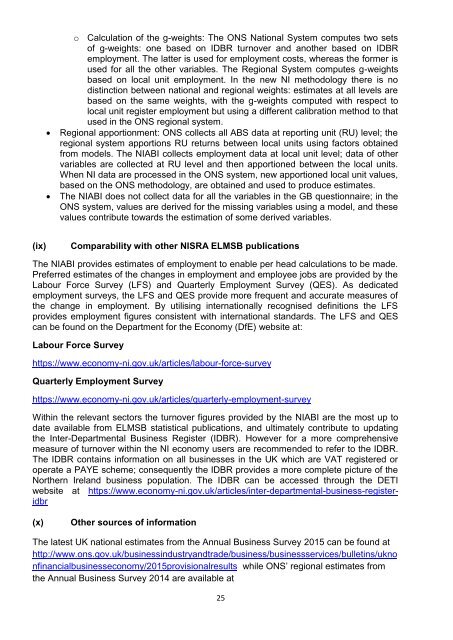ABI-2015
ABI-2015
ABI-2015
You also want an ePaper? Increase the reach of your titles
YUMPU automatically turns print PDFs into web optimized ePapers that Google loves.
o Calculation of the g-weights: The ONS National System computes two sets<br />
of g-weights: one based on IDBR turnover and another based on IDBR<br />
employment. The latter is used for employment costs, whereas the former is<br />
used for all the other variables. The Regional System computes g-weights<br />
based on local unit employment. In the new NI methodology there is no<br />
distinction between national and regional weights: estimates at all levels are<br />
based on the same weights, with the g-weights computed with respect to<br />
local unit register employment but using a different calibration method to that<br />
used in the ONS regional system.<br />
Regional apportionment: ONS collects all ABS data at reporting unit (RU) level; the<br />
regional system apportions RU returns between local units using factors obtained<br />
from models. The NI<strong>ABI</strong> collects employment data at local unit level; data of other<br />
variables are collected at RU level and then apportioned between the local units.<br />
When NI data are processed in the ONS system, new apportioned local unit values,<br />
based on the ONS methodology, are obtained and used to produce estimates.<br />
The NI<strong>ABI</strong> does not collect data for all the variables in the GB questionnaire; in the<br />
ONS system, values are derived for the missing variables using a model, and these<br />
values contribute towards the estimation of some derived variables.<br />
(ix)<br />
Comparability with other NISRA ELMSB publications<br />
The NI<strong>ABI</strong> provides estimates of employment to enable per head calculations to be made.<br />
Preferred estimates of the changes in employment and employee jobs are provided by the<br />
Labour Force Survey (LFS) and Quarterly Employment Survey (QES). As dedicated<br />
employment surveys, the LFS and QES provide more frequent and accurate measures of<br />
the change in employment. By utilising internationally recognised definitions the LFS<br />
provides employment figures consistent with international standards. The LFS and QES<br />
can be found on the Department for the Economy (DfE) website at:<br />
Labour Force Survey<br />
https://www.economy-ni.gov.uk/articles/labour-force-survey<br />
Quarterly Employment Survey<br />
https://www.economy-ni.gov.uk/articles/quarterly-employment-survey<br />
Within the relevant sectors the turnover figures provided by the NI<strong>ABI</strong> are the most up to<br />
date available from ELMSB statistical publications, and ultimately contribute to updating<br />
the Inter-Departmental Business Register (IDBR). However for a more comprehensive<br />
measure of turnover within the NI economy users are recommended to refer to the IDBR.<br />
The IDBR contains information on all businesses in the UK which are VAT registered or<br />
operate a PAYE scheme; consequently the IDBR provides a more complete picture of the<br />
Northern Ireland business population. The IDBR can be accessed through the DETI<br />
website at https://www.economy-ni.gov.uk/articles/inter-departmental-business-registeridbr<br />
(x)<br />
Other sources of information<br />
The latest UK national estimates from the Annual Business Survey <strong>2015</strong> can be found at<br />
http://www.ons.gov.uk/businessindustryandtrade/business/businessservices/bulletins/ukno<br />
nfinancialbusinesseconomy/<strong>2015</strong>provisionalresults while ONS’ regional estimates from<br />
the Annual Business Survey 2014 are available at<br />
25



